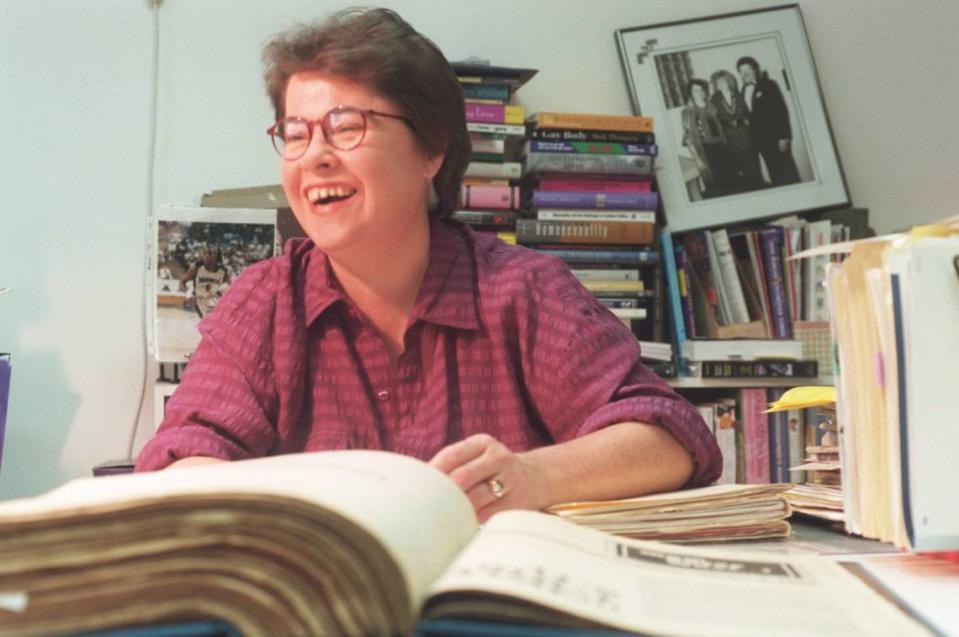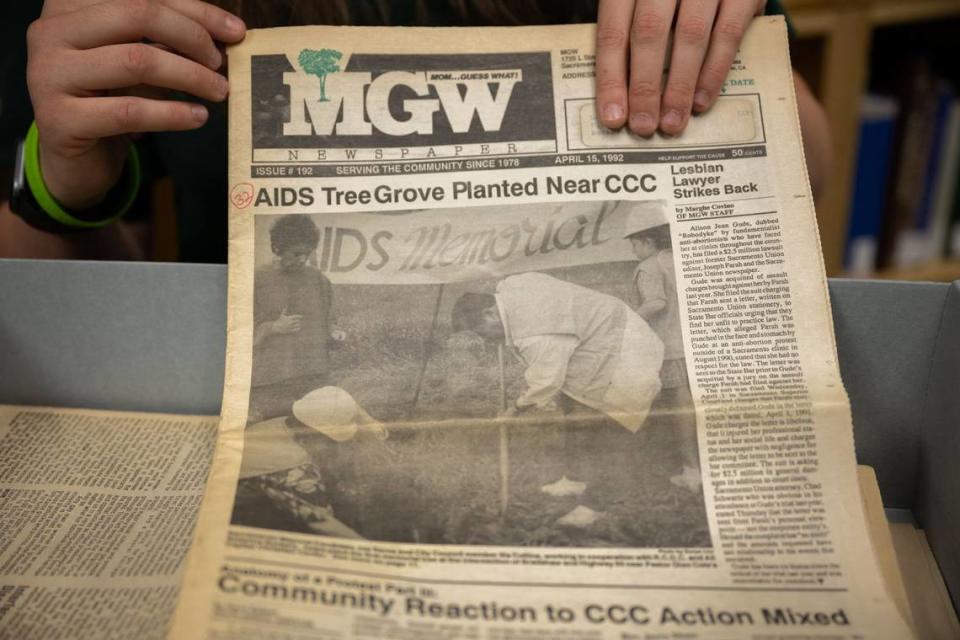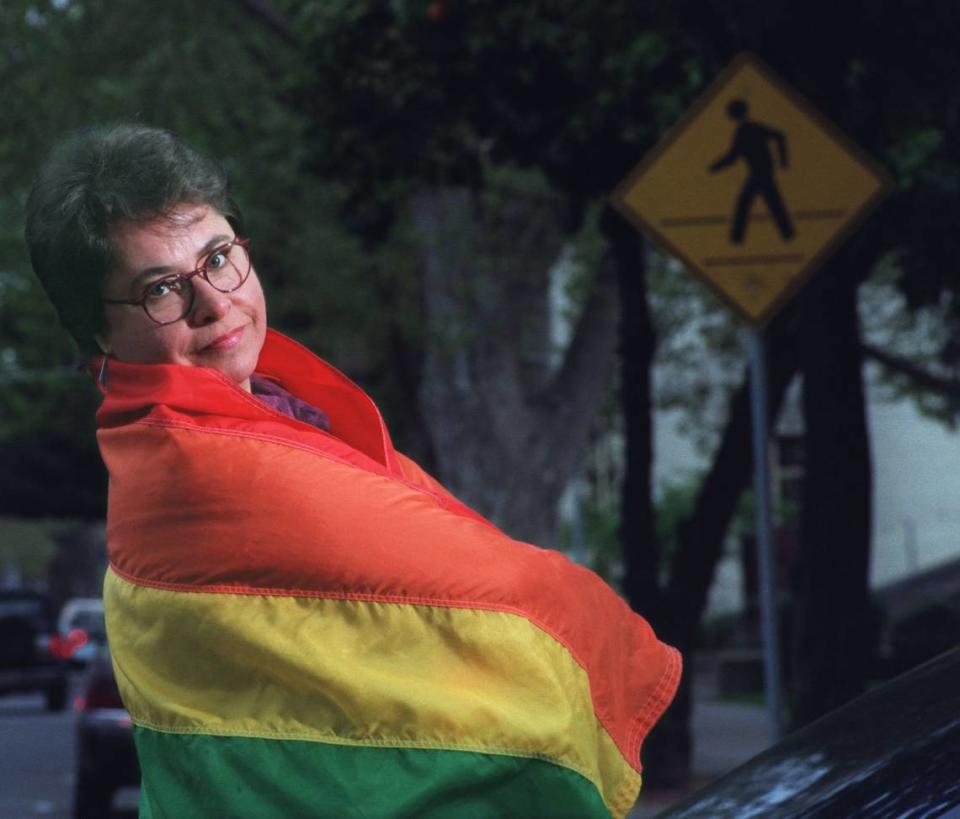Sacramento’s LGBT newspaper archive went missing. Here’s how the community brought it back
An unofficial but near-complete print archive of a pioneering LGBT newspaper from Sacramento is spread between two libraries in the region.
The paper, Mom Guess What was founded Nov. 1, 1978 by Linda Birner and published until around the end of 2009. Birner approached the Center for Sacramento History around late 2021 to donate some copies of her publication and other items, telling staff not long thereafter that file cabinets with voluminous copies of the paper had been taken and destroyed.
The center followed up on her claim by seeking to rebuild the archive for Mom Guess What, among the first LGBT papers in city history along with others like the Sacramento Star, Patlar Gazette and the earliest-known, ARC News. As part of this effort, the center hosted a June 6 event in Sacramento where attendees were asked to check for issues at home.
That said, the Peter J. Shields Library at University of California, Davis holds the majority of Mom Guess What’s approximately 585 issues, including all but one of the first 162 issues. Nearly all the issues the library lacks can be found at Sacramento’s Lavender Library, which has spotty print copies of the paper before 1989 but comprehensive volumes thereafter.
The question is how soon a complete archive of a once-influential publication can become available online. Already, the work the Center for Sacramento History has been doing has spurred renewed public interest and media attention for Mom Guess What, including segments in the past year by ABC 10 and CBS 13.
“It’s a service to our community that’s difficult to overstate,” said former California State Assemblyman Dennis Mangers during a panel at the June 6 event.
How the paper got started
Approximately 150 people attended the center’s event, which was held at the Clunie Community Center in McKinley Park to highlight the history of the newspaper and Birner. Aside from Mangers and Birner, the panel included former Nevada City lawyer Rosemary Metrailer and an early Mom Guess What editor Frank J. Lawler.
As he was waiting to give introductory remarks, Sacramento Mayor Darrell Steinberg waved his arms for the audience to give Birner a standing ovation. “The story of Linda Birner and Mom Guess What is a story that must be told,” Steinberg told the crowd.
Birner had moved to the Sacramento area in childhood, done graphic design work after attending California State University, Sacramento and been active in the National Organization for Women, or NOW, in the years prior to launching her paper when she was 29.

Steinberg told the crowd about how Birner’s paper got its start: As a call to arms six days before the Nov. 7, 1978 election to oppose Prop. 6, a ballot initiative by California State Senator John Briggs that would have removed gay and lesbian people teaching in schools.
“Every generation has its John Briggs,” Steinberg told the crowd. “Ron DeSantis comes to mind.”
The first issue of what was initially called MOM…GUESS WHAT…! – the paper styled its name in different ways over the years – sold for 25 cents, with a note from Birner and early executive editor David C. Weinerth on the front cover. Inside, readers could see how local candidates lined up on Prop. 6 and get names of the initiative’s financial backers.
Prop. 6, which also had prominent opponents like San Francisco Supervisor Harvey Milk, who would be assassinated 20 days after the election, failed resoundingly with voters. And that was just the beginning for Birner’s publication.
A gathering point for the community
Throughout its run, Mom Guess What was accessible to both LGBT and straight readers. For heterosexual readers, Birner, a lesbian, wanted to provide education. But the paper was also intended in part as a community resource for gay and lesbian people, a gathering point beyond bars.
“I just want to remind those of you that are younger that there was no internet,” Metrailer said during the panel.
Sure, readers of Mom Guess What could certainly find articles about serious news like the AIDS epidemic or how politicians like Steinberg, Robert Matsui or Anne Rudin were supporting gay rights. But the paper also contained softball schedules and ads for various local businesses, some of them LGBT-owned, others just supportive.

Steve Hansen, the first openly-gay person to have served on Sacramento City Council and a current mayoral candidate, told the Sacramento Bee that he used publications like Mom Guess What and Outword Magazine to make friends when he moved to the city in 2002.
“When you’re a young gay person, at least it used to be when you arrived in a new town, you’d go pick up the gay newspaper,” Hansen said.
Gregory Herek, a UC Davis professor emeritus of psychology who wrote a column for Birner’s publication in 1982 said the paper “played an important role in the development of a community in Sacramento.” When he retired from UC Davis around 2017, Herek donated some of his personal collection of the paper to the Shields and Lavender libraries.
Lawler said during the panel that people contributed to Mom Guess What in lots of ways.
The paper attracted some prominent supporters. Birner spoke during the panel about McClatchy Newspapers president C. K. McClatchy II, who died in 1989, providing informal editorial guidance. Birner also said Tower Records founder Russ Solomon handed her checks three times for $2,000.
Jane Fonda even attended Birner’s 40th birthday party in 1989, with a picture of her, Birner and Lawler hanging in Birner’s Sacramento home.
At the center of everything for more than 25 years was Birner.
“Linda Birner was an example of leadership,” Mangers said during the panel. “It’s hard to describe.”
Why Mom Guess What declined
Birner was reluctant to talk on the record about the alleged destruction of issues of Mom Guess What taken from its file cabinets or what caused her publication’s demise.
What’s clear is that by the early 2000s, what was by then known as Mom Guess What Newspaper was struggling. Birner left the paper without fanfare in mid-2004, saying when interviewed for this article that she had been sick in the hospital at the time.
Editorial manager Matthew Burlingame took to the pages on June 15, 2005 to discuss the revamped paper.
“In the past year, MGW has seen many changes,” Burlingame wrote. “It had a new owner working as a one-man army to take a newspaper with a dwindling readership and severely damaged reputation and change it into the respected news source that it once was.”
What caused the damaged reputation, Burlingame didn’t say in his note.
MGW existed in different forms for another few years thereafter, with the last issue available at the Lavender Library being No. 565 from Dec. 1, 2009. Faces Nightclub owner Terry Sidie, who recently donated $20,000 to the library, is listed as publisher of that issue.
Whether the paper was a victim of the Great Recession, had internal issues or experienced the same decline in advertising revenues that many publications have in recent years with the rise of the internet was unclear. Sidie didn’t respond to a request for comment Monday.
How Mom Guess What is being rediscovered
Sabrina Holecko, an archivist for the Center for Sacramento History spent months helping plan the June 6 event and has visited Birner’s home to take donations for the center. Holecko said Birner sought the center out hoping remnants from her life wouldn’t go to waste.
“She was just everywhere,” said Holecko, whose center has 22 boxes related to Birner or her publication. The holdings include eight boxes of issues that are fairly complete beginning around November 1988, but scattered before and can be viewed by the public by appointment.
Quietly, though, there had already been work over the years by other organizations to preserve Mom Guess What’s legacy. Between the Lavender and Shields libraries, only two Mom Guess What issues are clearly missing: No. 34 from September 1981, when the paper was a monthly; and No. 184 from Dec. 15, 1991, by which point it came out twice a month.
Kerry Parsons, a board member for the Lavender Library said it has been accepting donations of different materials since at least 2000 when it moved into its current location on 21st Street. Aside from its print holdings, the Lavender Library also has microfilm of some Mom Guess What issues, though Parsons indicated this isn’t exhaustive.
By the time Herek made his donation to the Shields Library, UC Davis already had extensive holdings related to Mom Guess What The university also recently received an $18,000 grant from the California State Library for “digitizing and preserving rare, historical LGBTQ+ newspapers, magazines, and other periodicals,” according to a webpage for the award.
Kevin Miller, UC Davis’s head of archives and special collections, said via email that because many issues of Birner’s publication from 1978 to 1990 have been digitized through Gale, the university was focusing its digitization efforts on its Mom Guess What holdings spanning 1991-2008.
More work remains to make Mom Guess What broadly accessible digitally, though there is some willingness among the Center for Sacramento History, Shields Library and Lavender Library to work together.
UC Davis is currently in discussions with the Center for Sacramento History that could help make issues available through archive.org once they’re digitized. Parsons also said via email, subsequent to granting a phone interview for this article, that they “would very much be open to working with other organizations.”
Writing her own story
At 74, Birner retains a keen memory about people who wrote for her, being quick to offer them praise and to note which writers are still living. Asked about Gary Miller, who wrote for the paper many years and eventually served on the Roseville School Board, Birner said he had died.

“Without the newspaper, you don’t know anything,” Birner said. “All the other gay papers that try, you don’t learn that Gary Miller died. You don’t learn anything, because what those newspapers are doing, they’re pulling out press releases off the news lines and they’re running those types of stories. They’re not writing their own stories.”
Birner then corrected herself to say that some papers did these stories, but the message was clear: When Birner published Mom Guess What she wrote her own story.

